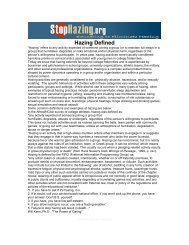Sorority Rituals - Reflections On Rites of ... - Mari Ann Callais
Sorority Rituals - Reflections On Rites of ... - Mari Ann Callais
Sorority Rituals - Reflections On Rites of ... - Mari Ann Callais
You also want an ePaper? Increase the reach of your titles
YUMPU automatically turns print PDFs into web optimized ePapers that Google loves.
To better understand Gilligan’s Female Stages <strong>of</strong> Moral Reasoning and the transitions<br />
between the different levels the following are included here to provide an understanding <strong>of</strong> the<br />
various phases that a female develops through:<br />
Level 1: The Orientation Toward Self-Interest<br />
At the simplest level <strong>of</strong> moral reasoning, women are pragmatically preoccupied with selfinterest<br />
and survival. At this level, moral consideration would enter the reasoning process<br />
only if the subject’s own needs were in conflict. Decisions at this level are made for what<br />
would be best for the subject, without consideration for anyone else (Muss, 1988, p. 233).<br />
The First Transition: From Selfishness to Responsibility<br />
The individual begins to become aware <strong>of</strong> the difference between what she wants<br />
(selfishness) and what she ought to do (responsibility) . . . . This growth from egocentric<br />
selfishness to an emerging concern for others is the first major step from childhood<br />
toward a more mature level <strong>of</strong> moral reasoning (Muss, 1988, p. 234).<br />
Level 2: Identification <strong>of</strong> Goodness With Responsibility For Others<br />
During adolescence, <strong>of</strong>ten development leads to the next higher level <strong>of</strong> moral reasoning<br />
and allows a societal perspective to emerge. In this stage, the young woman equates<br />
goodness with self-sacrifice and with pleasing and care for others. When a problem<br />
cannot be resolved in the best interest <strong>of</strong> everyone, she will sacrifice her own preferences<br />
to redefine the problem in terms <strong>of</strong> care and responsibility to others. The ability to value<br />
and assert oneself implies danger because it can lead to criticism, even abandonment by<br />
others (Muss, 1988, p. 234).<br />
The Second Transition: From Conformity to a New Inner Judgment<br />
The beginning <strong>of</strong> critical questioning about her own value characterizes the second<br />
transition. The young woman begins to wonder whether her concerns are really selfish or<br />
whether considering one’s own values and needs, not only those <strong>of</strong> others, might actually<br />
be responsible. The essence <strong>of</strong> this transition is the change 'toward a new conception <strong>of</strong><br />
goodness which turns inward in an acknowledgment <strong>of</strong> the self and an acceptance <strong>of</strong><br />
responsibility for decision' (Gilligan, 1977, p. 500). However, the individual’s perception<br />
<strong>of</strong> her self-worth is still too uncertain to allow her to claim full equality with others<br />
(Muss, 1988, p. 235).<br />
Level 3: Focusing on the Dynamics Between Self and Others<br />
At the third level <strong>of</strong> moral reasoning, which many never attain, the individual develops a<br />
universal perspective. At this level, a woman no longer sees herself as submissive or<br />
powerless; she has become an active and equally valid participant in the decision-making<br />
process. She has learned to verify her capacity for independent judgment and the<br />
legitimacy <strong>of</strong> her own point <strong>of</strong> view. The woman’s criteria for decision making are<br />
predicated upon a transformed understanding <strong>of</strong> interpersonal connectedness and on care<br />
for others (Muss, 1988, p. 235).<br />
53



